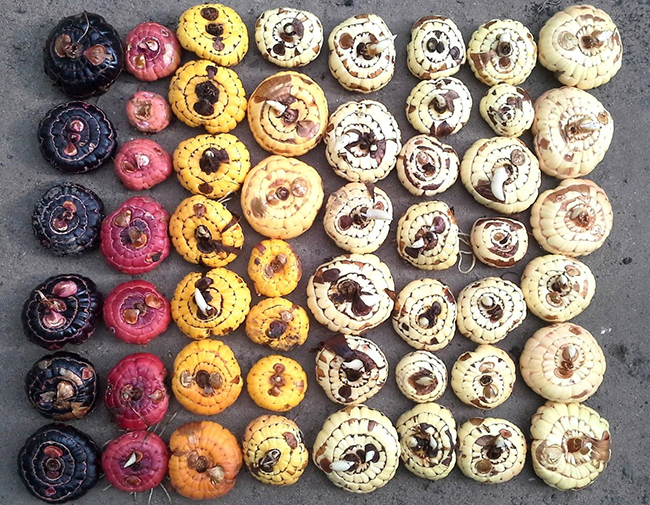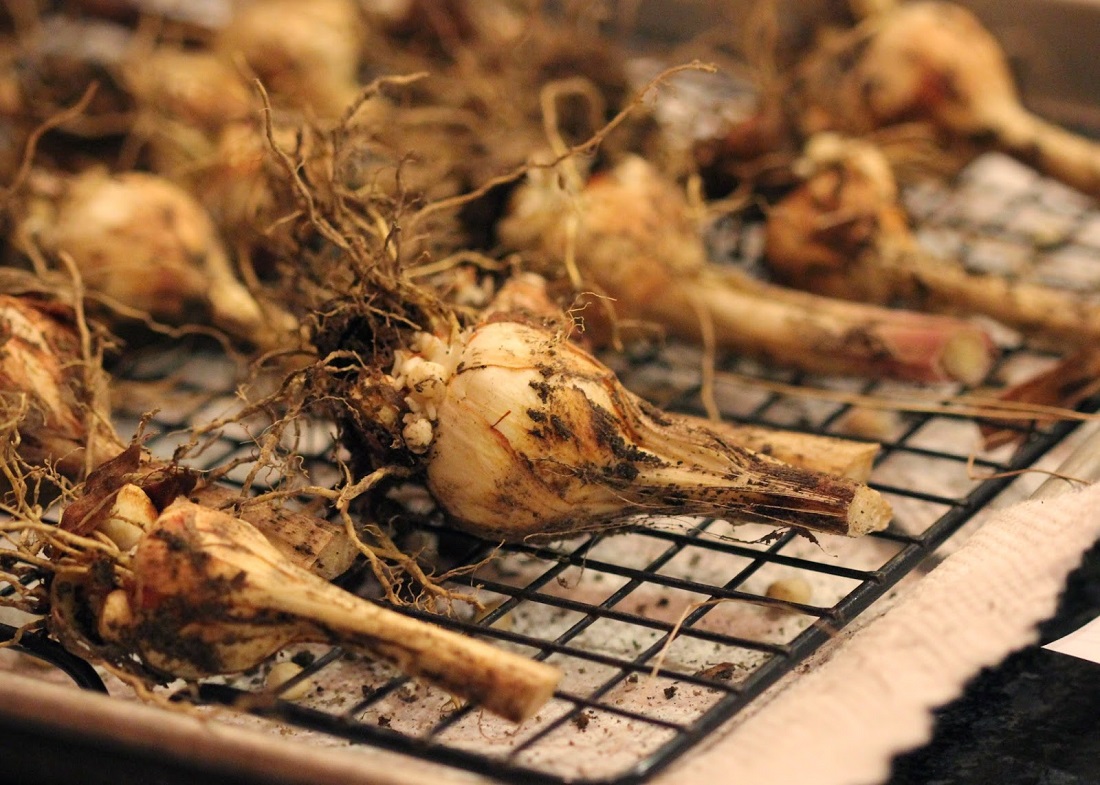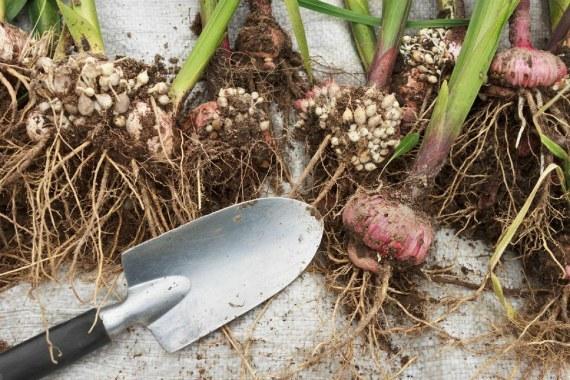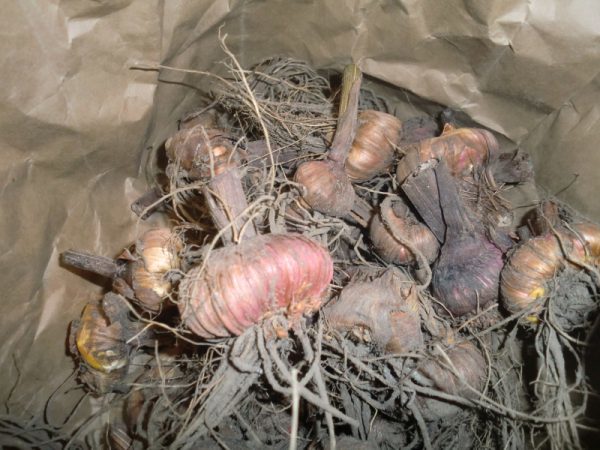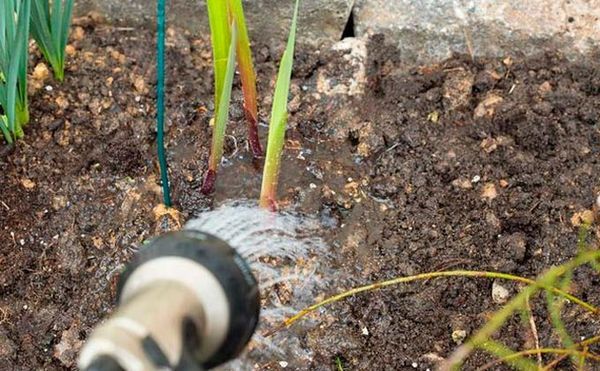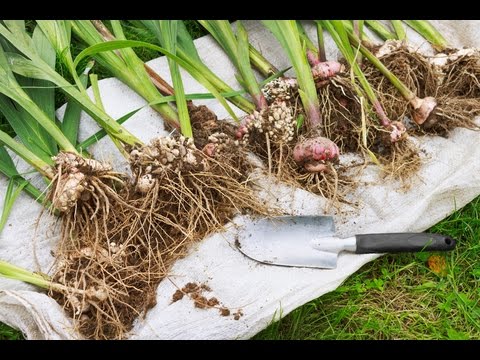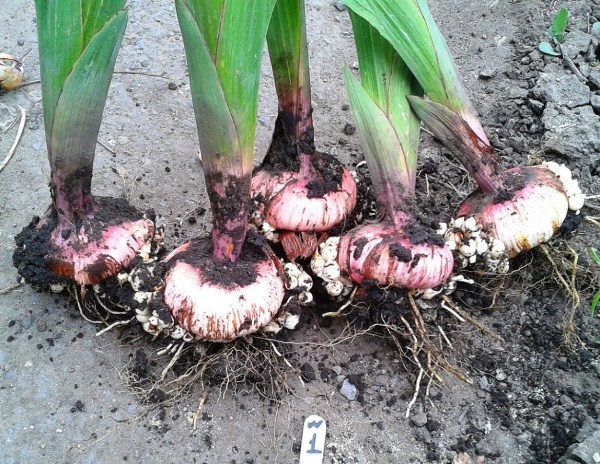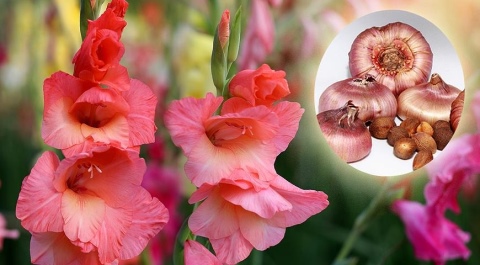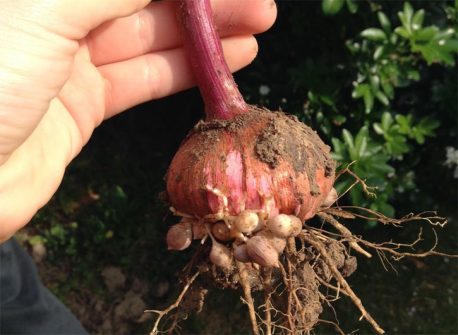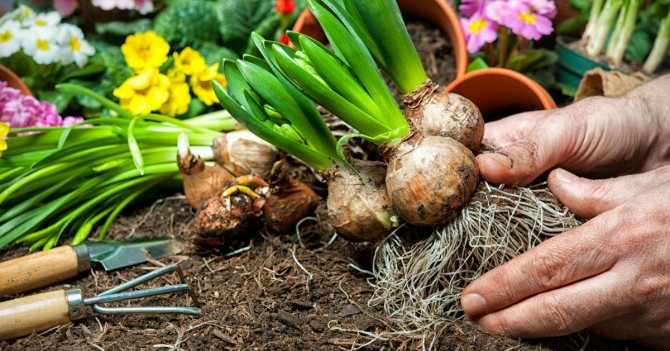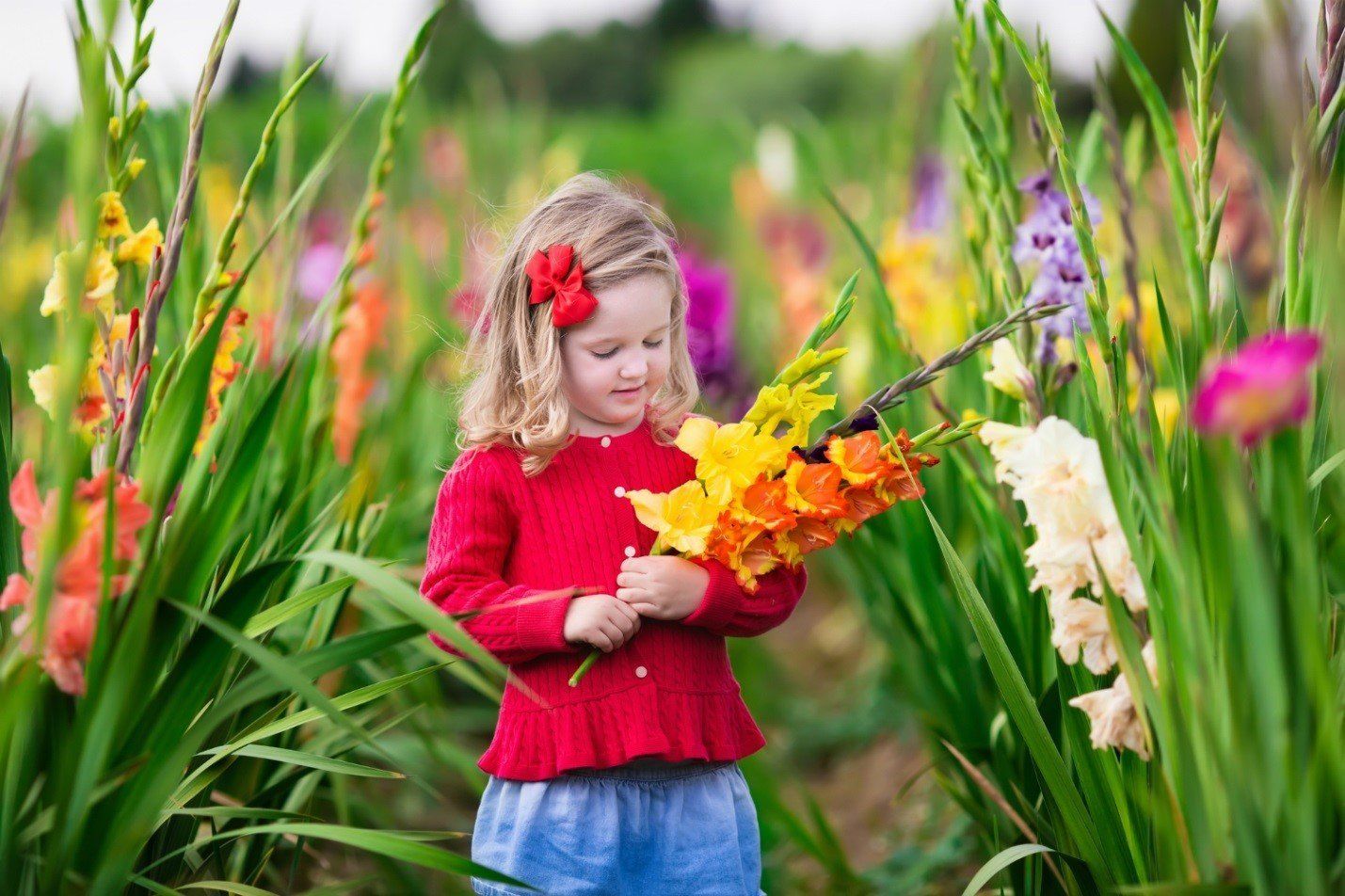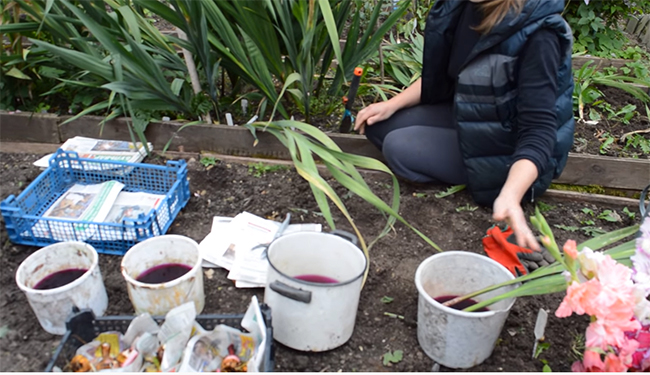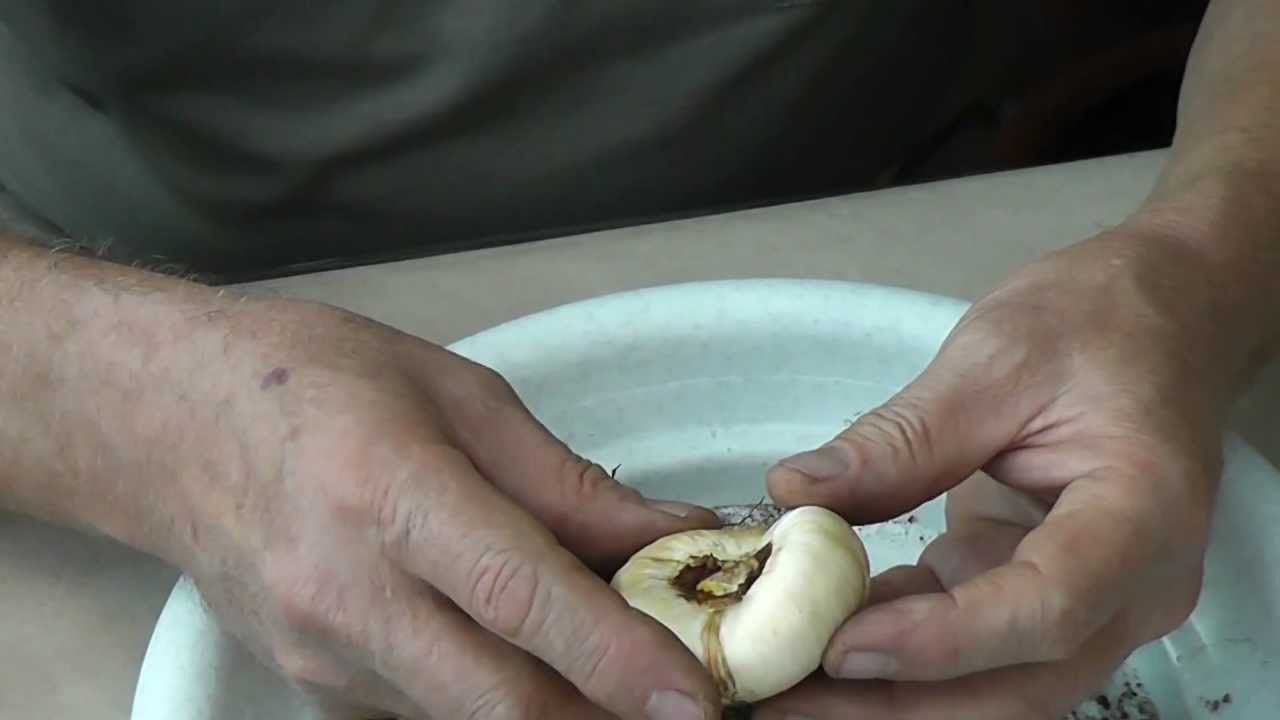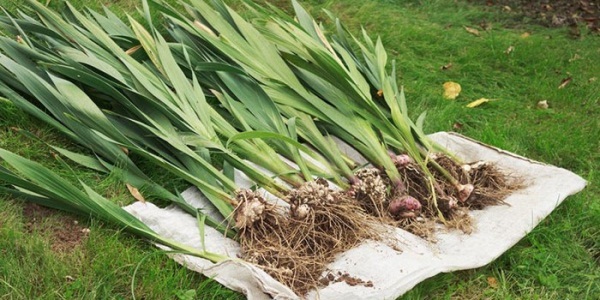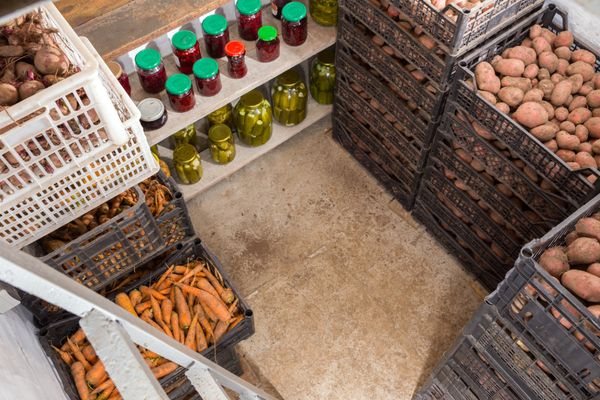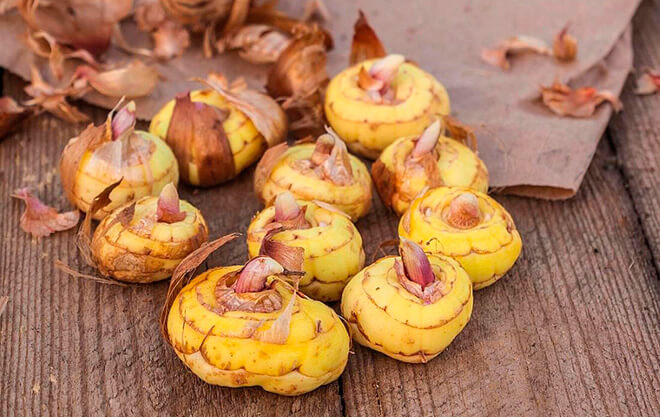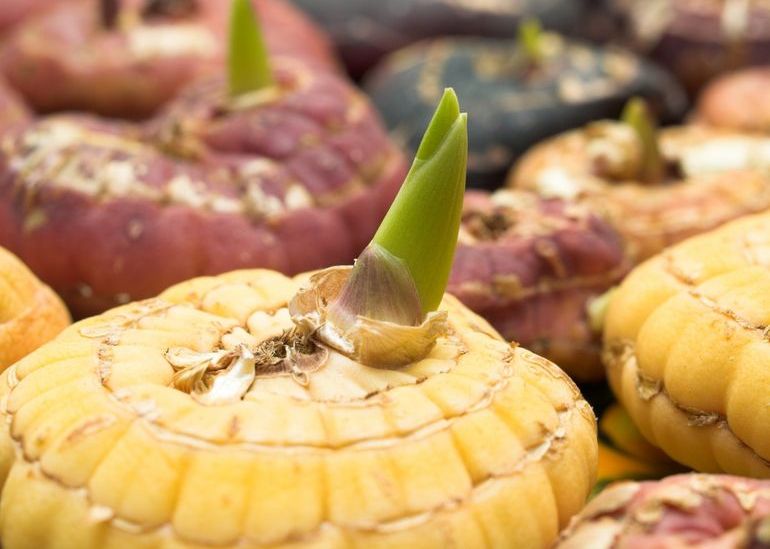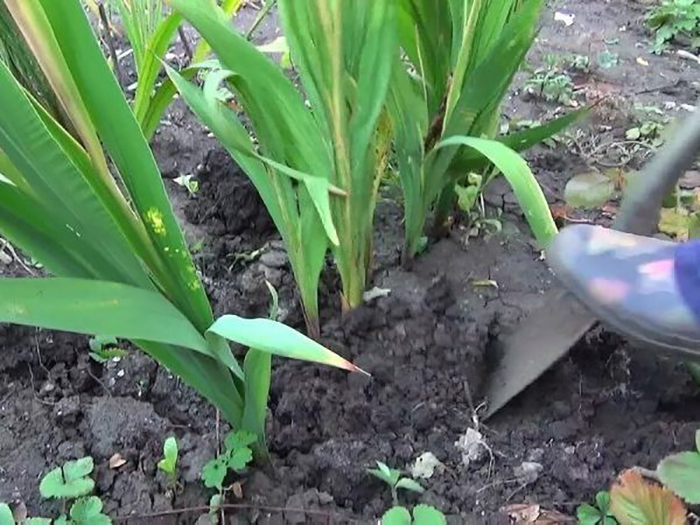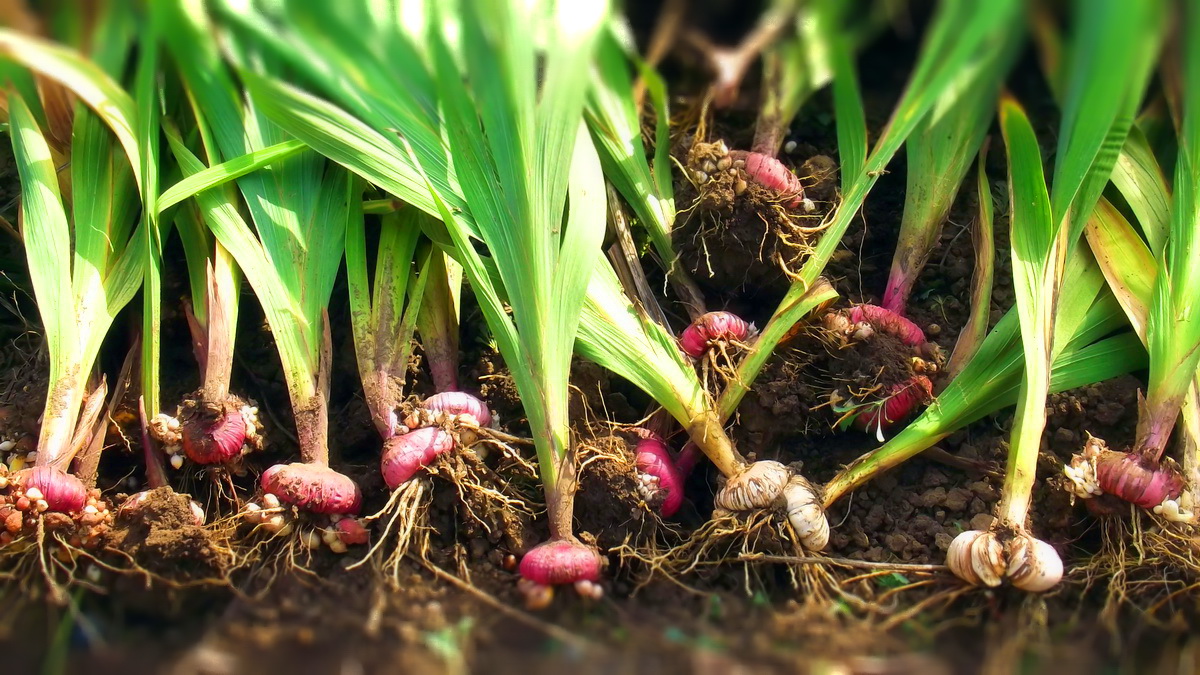Features storage of bulbs
The owner does not always manage to take the tubers from the territory of the dacha to the city for the winter. In this case, you do not need to be very upset, since such flowers can be stored right outside the city.
Using the cellar
A cool and dry cellar with good ventilation is a good place to store the tubers of the plant. But if you decide to place the tubers for the winter in this particular place, then you need to take into account one feature: in addition to gladioli, there should not be any vegetables and fruits in the cellar, since they can release a large amount of moisture, which provokes the appearance of mold.
The large bottom of the bulb indicates its old age. In this case, you need to try to rejuvenate the plant.
Inside the cellar, it is important to maintain a single temperature regime of 4-76 degrees Celsius - this condition is considered mandatory. You also need to closely monitor the humidity indicator, it should fluctuate between 65-80 percent
The storage of gladiolus babies is carried out in a cooler place with high humidity.
If you have a special mesh, then you can create boxes for storing material. The mesh, which is stretched to the bottom, will help to provide high-quality ventilation, which will protect the tubers from rotting.
Inside the trench
To store tubers, you can use a special trench. This method can work well when your area does not have too frosty winters. Groundwater should flow near the selected storage location
At the same time, it is very important to complete the construction of the trench before the onset of a cold snap.
Home storage
Storing gladioli after digging in an apartment will be quite difficult.
It is very important for this to find a place in which there will be no sudden changes in temperature. In this case, the indicator on the thermometer should range from 5 to 10 degrees, and the humidity should be in the range from 60 to 70 percent
Such conditions can only be found in rooms that are isolated from batteries.
A more suitable place for storing bulbs in an apartment would be:
- openings between frames, windows or doors to the balcony;
- glazed loggia;
- entrance hall next to the front door (entrance area);
- toilet (bulbs can also be placed in the toilet next to cold water pipes);
- pantry without heating system.
Loggia in this case will be the best option for storage. With the onset of frost, the tubers are best placed in an insulated box with a thermometer inside. Do not place the box on the floor; use boards or a backing for this. If the frosts are too strong outside, then a blanket or a warm and blanket can be thrown over the bulbs.
Regardless of the storage location of the gladiolus material, it is imperative to ventilate it. If you notice that mold has suddenly appeared on the bulbs, then it must be thoroughly dried. When any stains are formed, pruning is necessarily carried out, and the sections are filled with a solution of potassium permanganate. In this case, the bulbs must be treated with Maxim, dried and put in an airtight bag. If some tubers become too hard, then they must be thrown out immediately - they are prohibited from using for planting a plant.
How to properly dry gladiolus bulbs
After removing the bulbs from the ground, the roots must be trimmed. Then, shaking off the soil, it is necessary to separate the children. Corms should be placed in boxes with a trellised bottom, each variety separately.
After rinsing them with running water, it is necessary to decontaminate them by placing the bulbs in a solution of foundationol (1%).After about half an hour, they are washed again, treated with a solution of potassium permanganate (3%) and left to dry for 3 days.
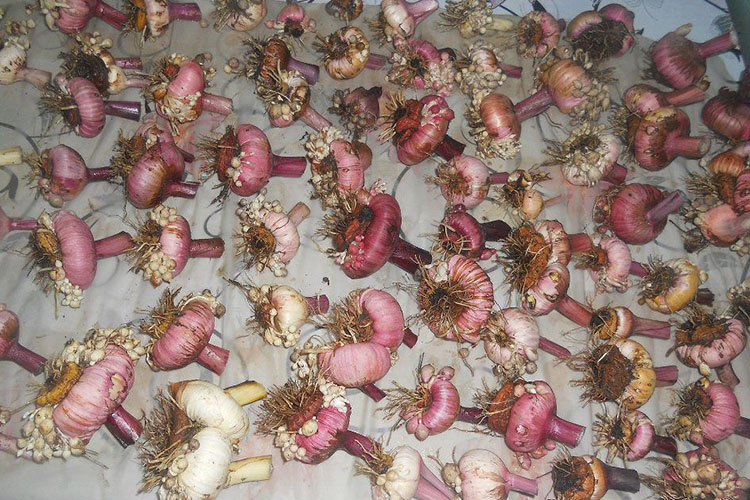
Then the bulbs are put in boxes, pre-lined with paper, and left to be stored, periodically turning over
It is important that the air temperature is at least 25-30 ° C.
After about two weeks, the temperature should be reduced to 19-22 ° C. After a month, the corms are cleaned and sorted, separating the children from them, which are also sorted by size and grade.
Children with a diameter of more than 0.8 cm are considered large, and if the diameter is about 0.6 cm - medium. They are stored in paper bags at a temperature not exceeding 5-6 ° C. A higher temperature is dangerous for them, as it threatens with loss of germination. The best option is to put them in the refrigerator.
How to store gladioli in the winter at home?
To avoid drying out the tubers during the winter months, place them in a cool room with high humidity levels.
Temperature regime
In the room where they are placed in order to preserve the corms of gladioli, the temperature should reach 8-9 ° C. At elevated temperatures, the tubers may begin to germinate, and the seedlings that have stretched out by April will not be able to please with flowering.
Temperatures below 6 ° C in the storage room provoke freezing of the planting material. The humidity level should be between 78-80%.
Storage in apartment conditions
To ensure the best preservation of gladioli tubers in the apartment, you will need to choose a place in which there will be a suitable temperature regime.
The best places in this case would be:
Window sills near wooden frames due to the lack of tightness.
Hallway.
Common vestibule.
Glazed balcony / loggia
It is very important to control the temperature in this room in order to prevent the soil from freezing. To maintain moisture, you will need to wrap all the bulbs with a triple layer of paper.
To avoid overheating, it is better to refuse storage in polyethylene.
To maintain moisture, you will need to wrap all the bulbs with a triple layer of paper. To avoid overheating, it is better to refuse storage in polyethylene.
Cellar storage
The cellar is considered an ideal place to store gladioli. This is where all the bulbs can be saved without loss. As a rule, the temperature in the basements is in the range of 3-8 ° C, and the humidity level reaches 75-80%.
For storage, it is recommended to use mesh boxes that can be stacked one on top of the other up to the ceiling. This method takes up a minimum amount of space. In this case, the tubers will be ventilated, which will avoid overheating.
It is unacceptable to store gladioli tubers and fruits in one box. The latter release moisture, which will lead to rotting of the planting material.
Cold storage
To keep the corms in good condition until spring, you can use the refrigerator. It is here that the temperature regime is kept at a certain level. Tubers can be placed in compartments for vegetables, after wrapping the planting material in several layers of paper.
It is advisable to open the paper every 10-12 days and check the condition of the tubers. In case of dampness or mold, the bulbs are removed for re-drying and then wrapped in dry paper.
Storage on the loggia
Often, the owners of summer cottages bring skewer bulbs for storage on a glazed balcony / loggia. In order to place the planting material, you will need to prepare containers from heat-insulating materials in advance.
The containers are placed on planks with which it is necessary to lay the floor surface. The bulbs, wrapped in paper, are laid out in containers and covered with several layers of thick burlap.
Systematically control the temperature on the balcony so that it does not drop below 6 ° C.With this temperature regime, the risk of tubers freezing increases.
Rules for planting gladioli and caring for them in the open field
First of all, we decide on the place. The place where potatoes and carrots grew before is not suitable for planting skewers. Also, you should not choose places where manure was previously introduced - gladioli do not tolerate it. Suitable predecessors include marigolds, dahlias, tomatoes, and peas. Also, you should not choose shaded places and those where groundwater is close.
Acidic soils are also unsuitable, or the soil for flowers must first be deoxidized. On heavy soils, sand is added. Gladioli do not like organics, but mineral fertilizers must be applied for digging. To get the desired result from growing gladioli, you need to adhere to the following rules:
- the bulbs are embedded to a depth equal to four diameters of the bulb itself;
- the distance between tubers should be from 15 to 20 cm;
- the bottom of the trench should be drained with sand or sphagnum;
- the soil during planting must have a temperature of at least 10 ° C.
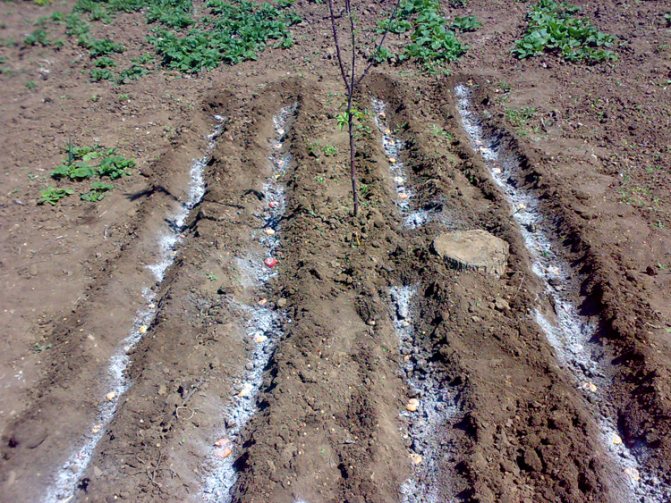
Landing gladioli in trenches
Top dressing is carried out after the release of the first leaves - with nitrogen fertilizer, after the release of the sixth leaf - with phosphorus-potassium, when laying the buds, you can apply a solution of bird droppings. Spraying with a solution of potassium permanganate, copper sulfate and boric acid also works well.
Useful Tips
To avoid such unpleasant situations and make the storage of gladioli bulbs as productive as possible, you need to take into account several recommendations of experienced florists. There is an opinion that the planting material will be able to withstand a long winter if it is regularly ventilated and checked for the presence of putrefactive formations or damaged areas.

If rot appears in any place on the onion, you do not need to rush to throw the onion into the trash. There is another way to solve the problem. To do this, you need to get rid of the affected part and treat the tuber with a weak solution of potassium permanganate. Then it is sprinkled with ash and placed in another place to avoid contamination of healthy specimens.
Very often, the tubers of gladioli begin to dry out. If this happens, don't panic. Just before you start planting in open ground, you need to soak them in cool water for half an hour. For a more productive rooting, the water can be diluted with a stimulating substance.
As the heat returns in spring, the tubers will sprout too quickly. For such a process to be carried out as quickly as possible, it is better to move them to an environment with good illumination and a higher ambient temperature and maintain there for several weeks.
It is not difficult to protect gladiolus bulbs from death in winter. To do this, it is enough to take into account the principles of storage, as well as provide them with proper care. In this case, the seed will move freely from year to year, as well as produce healthy and beautiful flowers for the next warm season. The immune system of perennials becomes stronger every year, which makes it possible for them to reproduce. Soon, favorite plants will transform the backyard beyond recognition.
Preparing gladiolus for winter
Digging out the bulbs is half the battle, the main point is preparing them for the cold weather. For this, the tubers are well dried and treated with antifungal drugs. Only then can they be put away for storage.
How does the digging take place

The soil at the time of digging should be dry; it is not necessary to water it in a few days. If it rained the day before, they wait for the earth to dry out. With a shovel, dig in the ground to a depth of 30-40 centimeters and take out the bulb. First of all, they dig up large tubers, leave small ones for later. The stems are cut in advance or during the digging process.
Then the seed is cleaned from the ground with a dry cloth and the condition is assessed.If there are visible signs of rot, mold or ulcers on the tuber, then it is not suitable for storage. Even one infected bulb can spoil all the others, thereby destroying all flowers.
Drying the bulbs
Plants can be dried both at home and outdoors. If the weather is warm and dry, then put all the tubers in one row in boxes covered with paper and leave to dry for at least 2 weeks. During this time, the skin should become more brown and rougher. If you touch it, it will rustle pleasantly.
At home, the bulbs are dried for about a month at a temperature of 22-26 degrees. Then the temperature is slightly reduced to 17-18 degrees and drying is continued for another 5-7 days.
Processing for the winter

To prevent the tubers from becoming infected with the fungus, they are treated with fungicidal preparations before harvesting. Most often they use a weak solution of potassium permanganate or a solution of copper sulfate. These substances prevent the formation of pathogenic microorganisms and protect the planting material from viruses and fungal spores.
Dilute any of these drugs and immerse the bulbs in it for 20-30 minutes. Then they are taken out, blotted with a towel and re-dried in the apartment. When the husk is completely dry and rusty, the gladioli are removed for storage.
Pest control
The most dangerous enemy of flowers are thrips. To prevent pest infestation, the bulbs are soaked in Inta-Vir. After processing, the planting material is dried again.
You can use handy products and prepare an equally effective solution for removing thrips from garlic. For him you will need:
- 200 ml of water;
- 1 head of garlic.

The cloves are crushed and put into water. Allow to stand for 20-30 minutes, then immerse the onions in the mixture for a couple of minutes and remove. When the skin is dry, the tubers are harvested and stored.
Another interesting way to prevent insect attacks is to treat gladioli with paraffin. The paraffin from the candle is heated until it takes on a liquid consistency, and the onion is quickly dipped in it. Tubers in paraffin are folded on oilcloth and allowed to dry. When it hardens, you can transfer the planting material to boxes.
Removal of gladioli tubers
Storing bulbs for the winter begins with digging out the planting material from the soil. This procedure is best done after the substrate has dried thoroughly. It should not be watered for several weeks before the event. Using a garden tool, you need to dig the ground to a depth of 30-40 centimeters and remove the bulb. First, large specimens should be removed from the soil, and then small ones. The remaining green stems are cut before starting to harvest or in the process.

After that, the dug tubers are cleaned of soil residues with a dry cloth.
At this stage, it is important to make sure they are healthy and free from defects such as:
- traces of mold;
- putrid formations;
- ulcers;
- lesions by disease.
Attention! It is important to understand that even one affected element can lead to the death of all others. A lack of attention to the seed is a serious threat to the future flower plantation.
Drying of the dug out bulbs can be carried out both at home and in an open space on the street.
But this is possible only in dry and warm weather for several weeks. To dry gladioli, you must use cardboard boxes lined with paper. In good weather conditions, the seed will dry out in 14 days. Over such a period of time, the skin will acquire a brown tint and become rough. If you touch it, you can hear the sounds of rustling
Drying of the excavated bulbs can be carried out both at home and in an open space on the street. But this is possible only in dry and warm weather for several weeks. To dry gladioli, you must use cardboard boxes lined with paper.In good weather conditions, the seed will dry out in 14 days. Over such a period of time, the skin will acquire a brown tint and become rough. If you touch it, you can hear the sounds of rustling.
When grown at home, the bulbs are dried under the influence of a temperature of 22-25 degrees Celsius. As the peel dries, the temperature regime can be changed to 17-18 degrees.
To avoid the defeat of the tubers by fungal diseases, before removal, they must be treated with fungicides. For this, a solution of potassium permanganate or copper sulfate is used, which prevents the problem of pathogenic microorganisms on plants and forms a natural defense of the material against dangerous diseases and fungi. The mentioned agent must be diluted in water, and then the tubers must be immersed in it for half an hour.
Ultimately, the processed bulbs are removed from the liquid and re-dried in the apartment. If the husk is completely dry and begins to rustle, the planting material can be placed in a suitable space for long-term storage.
The timing of digging out the bulbs
 Autumn is the time to dig out bulbous crops. Of course, it all depends on the type of culture, they are early, middle and late. If you do not have the opportunity to determine the variety, then after flowering, 3-4 weeks should pass before you can dig out gladioli for the winter. You can wait even longer, the main thing is to have time to dig it before severe frosts. During this time, the bulbs have time to grow. Dry weather is chosen for harvesting bulbs. Since it is easier and faster to dry them in dry weather.
Autumn is the time to dig out bulbous crops. Of course, it all depends on the type of culture, they are early, middle and late. If you do not have the opportunity to determine the variety, then after flowering, 3-4 weeks should pass before you can dig out gladioli for the winter. You can wait even longer, the main thing is to have time to dig it before severe frosts. During this time, the bulbs have time to grow. Dry weather is chosen for harvesting bulbs. Since it is easier and faster to dry them in dry weather.
Dig up gladioli with a shovel or pitchfork. In order not to damage the bulb, immerse the shovel or pitchfork into the ground at a distance of 15-20 cm from the plant. We dig in and pull on the dense stem, removing the bulb from the ground. Shake off the ground and cut off the stem shortly. Pests are very common at the base of the stem. Then we release the bottom of the tuber from the roots and tubers. If the harvesting of gladioli in the fall took place on time, then they need to be stored accordingly.
Fight against parasites
 If such dangerous pests as thrips have managed to infect the culture, you need to know how to deal with them, and how to store the tubers affected by the disease in winter. The success of the transfer of wintering depends on the timely detection of parasites in the tubers.
If such dangerous pests as thrips have managed to infect the culture, you need to know how to deal with them, and how to store the tubers affected by the disease in winter. The success of the transfer of wintering depends on the timely detection of parasites in the tubers.
Unfortunately, thrips is the least noticeable creature that can disguise itself in the seed of gladioli, so growers often do not have time to notice it when examining the bulbs. To avoid storing affected specimens with healthy ones, after removing them from the ground, it is necessary to carefully inspect each site.
To control thrips, a highly effective agent must be used before moving the bulbs for the winter. For example, you can use:
- Alcohol solution. Experienced flower growers claim that alcohol is the main enemy of any flower pests. And thrips are no exception. To get rid of such parasites, it is enough to place the tubers in a glass container, and then put a tampon soaked in alcohol there and carefully close the jar. Within a few hours, dangerous creatures will appear on the surface and die. If this does not happen, the procedure can be repeated.
- The drug "Actellic". Such a product must be diluted with a liquid in the proportion of 2 grams per liter. Then you need to put the seed in it and hold it there for five minutes. Then the bulbs are additionally dried at a temperature of 20-25 degrees Celsius.
- Decis solution. This product is sold in hardware stores and comes in ampoule form. Two ampoules are diluted in 10-liter warm water, after which the dug out seed is placed in the finished solution. After 30-40 minutes of processing, the tubers are dried.
There are other effective means of fighting thrips or any other parasite.The main thing is not to ignore the need to process the bulbs before placing them for winter storage in the house.
8 ways to store gladioli in winter
1. Waxing is a great way to keep gladioli at home, in an apartment in winter.
Storing gladioli in the winter at home is possible with the use of waxing. Dip the peeled corms in the paraffin melted in a water bath and immediately put them in cold water to quickly harden the paraffin. A shell forms on the surface, which prevents the formation of moisture and drying out of the corms. However, in the spring, when planting, you will need to rinse each corm in warm water to wash off the paraffin. It's not that easy. Sometimes you have to use a brush to clean it, and this can damage the bulb.
2. How to keep gladioli in the trench until spring.
If you live in your own home, then it will be very easy for you to keep gladioli until spring. Place the corms in a box, sprinkling them with dry sawdust or peat. Dig a trench about a meter deep and wide enough to accommodate a box of planting material on an elevated site. Place a box in the trench when the ground begins to freeze at night and thaw during the day. Cover the top of the box with dry foliage and plastic to prevent water from getting inside. Cover the trench with soil with a slide so that the water rolls off and trample it down. Such storage of gladioli bulbs in a trench is possible until spring. Of the minuses, it is worth noting that due to diseases, high humidity and lack of oxygen, part of the planting material may die.
3. How to keep gladioli in the apartment until spring.
Where to store gladioli at home in winter - for this you need to find a place where the temperature is kept at a constant level, about 5 - 10 degrees. Most often, such a place is a basement or cellar. Place the corms prepared for storage in a box with a mesh bottom and place them in the basement where the vegetables are stored. If the storage conditions are correct, then the planting material can lie like this for 2 winters without landing in the ground in the spring.
4. How to keep gladioli in the pantry in winter
In the pantry where canned vegetables are stored, you can also find a corner for storing gladioli bulbs. It is advisable that the temperature in the pantry does not rise more than 18 degrees. Properly prepared gladioli bulbs are placed in nylon stockings and hung on the walls. During the winter, they need to be periodically checked and dried corms that have begun to hurt should be removed.
5. Storing gladioli in a warm attic
In the insulated attic of a private house, you can make a place for the wintering of bulbous flowers. Pack them in a newspaper, put them in a drawer and place them close to the chimney.
6. How to properly store gladioli on a glazed loggia
You can store gladioli on a glazed loggia if you put the corms in a foam box with a wall thickness of at least 5 cm, and install a thermometer next to it to control the temperature. With a significant drop in temperature, it will be necessary to additionally insulate the box with the planting material with a sleeping bag or old fur clothes.
7. A way to store gladiolus tubers in the apartment in winter
In a city apartment, near a window facing north and away from heating appliances, it is possible to store gladioli in winter. To do this, the gladiolus bulbs are placed in a box in rows so that the corms do not come into contact with each other. Then they are covered with calcined river sand, charcoal or ash. The box is closed and periodically checked for safety.
8. In the refrigerator, in the lower vegetable compartment.
A very common way to store gladioli in the winter at home. Each corm is wrapped in paper and then placed in a bag with holes for air circulation. Store the bundle on the bottom shelf, not in a plastic container.It is humid there, a lot of bacteria collect, and this is harmful to gladioli. Storing gladioli bulbs in the refrigerator requires extra care. The package with planting material must be sorted out 2 times a month, replacing the damp paper, drying the wet bulbs with a hairdryer and returning everything to its place.
To preserve the bulbs of gladioli until spring, you need to observe the temperature and humidity. If it is violated, the corms may die. Often, when checking, gardeners notice that the corms of gladioli have softened. This means they are either frozen or cooked.
Any place where you will store gladioli after digging requires a mandatory inspection. It is necessary to ventilate the bulbs. With excessive moisture, the tubers can become covered with a gray-green bloom of mold, which is activated at high humidity and lack of oxygen. also in winter they can be struck by rot of various origins. Such gladioli must be destroyed.
Common mistakes
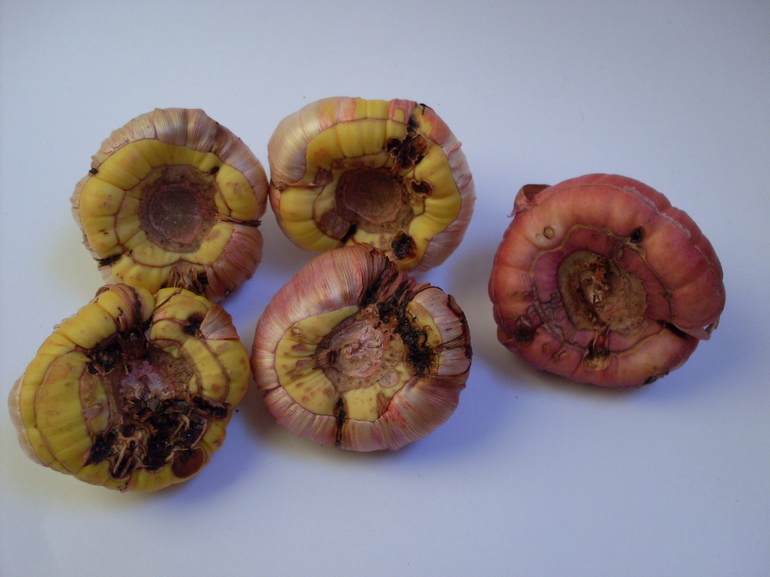 Many novice flower growers make a lot of mistakes when they begin to figure out where and how to properly store gladioli for the winter.
Many novice flower growers make a lot of mistakes when they begin to figure out where and how to properly store gladioli for the winter.
The following situations can be singled out as examples:
- The club material is pulled out of the soil too early, which prevents it from drying out normally.
- Before placing the bulbs in the storage area, the grower did not treat them with fungicidal and insecticidal agents.
- The required temperature regime for storage on the balcony was not observed.
- The seed was not getting the right amount of air and suffocated.
In addition, some growers fill a box or bag with tubers with sawdust or soil, believing that this will provide them with reliable protection from the cold. However, such care often leads to negative consequences, such as the penetration of moisture inside. In this case, the rotting of the bulbs will occur much faster.
How to prepare gladioli for storage
To prepare gladioli for storage, you first need to clean them of soil residues. If the contamination is too large, the tubers are washed under running water. It is more convenient to do this in a sieve.
- The stems of plants are cut in such a way that hemp remains no more than 1 cm. In longer stems, a pest dangerous for bulbs, thrips, often develops.
- You can shorten the drying time of the planting material if you remove the old bulb and roots.
- After pruning, the corms are placed in a fungicide solution. This procedure is needed to prevent disease before planting in open ground.
- Tubers should be dried thoroughly. To do this, they are laid out in a ventilated place with a temperature of at least + 25 ° C, and left there for 3 weeks. For another month, the planting material should be at room temperature (shelf, table). At the same time, he should provide frequent ventilation.
- The scales on the surface of the bulbs protect them from rapid evaporation of moisture, followed by wilting. Therefore, you do not need to take them off.
If the affected areas on the tubers are small, they are removed with a sharp knife, after which they are treated with brilliant green.

How to prepare bulbs for storage after digging
Calla bulbs, dahlia tubers, are taken out of the soil very carefully so as not to cut the flesh with a bayonet. The plant is buried in a circle, lifted by hands together with a lump of earth and put into a basket
The resulting material is prepared for storage as follows:
- Ripening. Immediately after digging, the calla lilies are placed in a cool place under the roof for preliminary drying along with the earth and leaves. Withstand 7-10 days until the green mass completely dries out. It is not recommended to pick off the stems right away, because when they die off independently, nutrients enter the tuber.
- Cleaning. The tops are removed and the rest of the soil is removed, being careful not to damage the roots. Washed in running water.
- Etching. To prevent mold and rot during storage, the tubers are dipped for 20-30 minutes in a fungicidal solution: "Maxim", "Inta-vir", "Fitosporin", potassium permanganate.
- Drying. Clean, processed corms are laid out in one layer on newspapers at a temperature of +25 .. + 28 ° for final drying. Withstand 7-14 days until a dense dark rind appears. The thick protective shell will keep the bulbs from drying out during hibernation.
The rhizomes of Ethiopian white calla lilies are dug and prepared in the same way as tuber hybrids.
Indoor calla lilies also need to rest for at least 10 weeks. But they are not specially prepared and they are not taken out of the pots.
Digging time
At the beginning of autumn, peduncles are cut off from all plants. There is no need to wait for the flower to dissolve all the buds. Peduncles are cut with a sharp knife at an angle so as not to damage the leaves.
Dig out the bushes after about two weeks. A signal to the fact that it is time to remove gladioli for the winter is a drop in air temperature to 10 ° C.

Depending on the variety
When harvesting bulbs, consider when the flower has finished blooming. Different varieties have different flowering periods, and therefore it is difficult to determine the exact date of harvesting gladioli in the fall for storage. Usually, the tubers are dug out if more than a month has passed since the end of flowering. During this period, the bulbs continue to ripen, accumulating nutrients for wintering. Still, plants should be harvested before their leaves begin to wither.
 You may be interested in:
You may be interested in:
The best varieties of gladioli of Russian selection It is difficult not to love gladioli, their powerful arrows, which are decorated with large flowers resembling butterflies. Flower ... Read more ...
In this case, the following nuances must be taken into account:
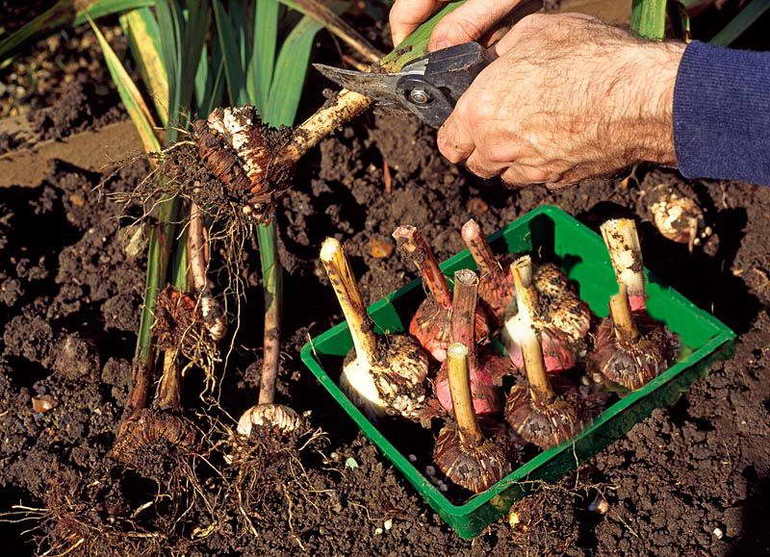
- The first to dig out the early and middle varieties. After them, late ones are dug up, as well as flowers grown from children.
- Since plants of dark shades (burgundy, black, purple, red) are most susceptible to diseases, they are removed first.
- Young plants, as well as those that have not yet bloomed, take longer to ripen the tubers. Because of this, such flowers are dug out at the very end. In young gladioli, the flower arrow often appears only at the end of summer.
- It is better not to wait for the complete maturation of the bulbs, as this will allow you to choose the tuber with the children. Ripe corms may crumble during harvesting, and children will have to be looked for in the ground.
Interesting! Some species of gladioli successfully winter outdoors. For example, the tiled gladiolus tolerates winter cold in the soil, and therefore does not need to be dug out in the fall. Unfortunately, such varieties are rarely found on the market.
According to the region of cultivation
In different regions of the country, the periods of digging gladioli differ. But flower growers always adhere to the rule: the tuber fully ripens within 35-50 days after the plant finishes blooming. It should be borne in mind that the bulb ripens faster after cutting the peduncle.

In the Moscow region, the flowering period for most plant species falls on August. Therefore, it is necessary to remove gladioli for the winter during September.
In Siberia and the Urals, due to climatic conditions, only early varieties are grown, since they manage to grow and bloom in a short summer period. They often bloom at the beginning of autumn with the first frost. Dig up the tubers before the air temperature drops to zero during the day.
 You may be interested in:
You may be interested in:
Gladioli: planting and care in the open field Gladioli are pompous and beautiful flowers on a long peduncle, which have a high decorative effect and ability ... Read more ...
In the southern regions of Russia, where in the winter months the temperature is rarely below zero, gladioli do not need to be dug up for the winter. In order for the flowers to survive the frost, it is enough to cover them with a film, agrospan or other covering material. If there is a chance that the winter will be cold, then when digging up, you should focus on the variety and flowering time of the plant. Bulbs are usually harvested from August to October.It is not recommended to keep them in the ground for longer than necessary.
Important! The northern regions and the middle zone of the country are distinguished by long and frosty winter months. Because of this, the tubers must be dug up in autumn, since otherwise they may get sick or freeze out .. When breeding gladioli, remember that:
When breeding gladioli, remember that:
- In the northern regions, flowers are planted rather late, and therefore sometimes the tubers do not have time to accumulate nutrients in time before wintering.
- In the middle lane, the bulbs are harvested at the end of September. And at the same time, frosts become permanent.
If the weather conditions did not allow leaving the tubers in the soil for the allotted time, experienced gardeners advise to dig them up together with an earthen clod and uncut stems. In this form, gladioli should be left in a warmed room for a period of slightly more than a month, only after that they should be processed.
Outcomes
Based on the information provided, we can conclude that it is quite simple to store gladioli in the refrigerator. The main condition is the presence of a spacious box. Designed for storing vegetables. If not. It is worth considering other options that allow you to preserve planting material in an apartment. Gladioli can be kept on the balcony or directly indoors, but there is a risk of premature germination, because such methods are rarely used.
When sending planting material for storage, you need to remember that all bulbs must be isolated from each other. Otherwise. If one element is damaged by rot, all copies may be lost. Also, during storage, you need to monitor the condition of the bulbs. They should be dense, without traces of bacterial damage. If you find any signs of spoilage, the bulb should be isolated.
Do not forget that the bulbs must be timely prepared for planting in the ground. To do this, they need to be removed from the refrigerator 3-4 weeks before the expected disembarkation. The material must be cleaned and treated with a fungicide. If all of the above conditions are met, the florist will be able to achieve the exuberant flowering of gladioli, which occurs at the end of summer.
Video: how and where to store gladioli in winter
I recommend to read:
How to store dried mushrooms at home - Drying is one of the most popular options to stock up on dried mushrooms for future use. Rules and methods for storing homemade products, terms and options for use in cooking ...
How to keep lemons fresh at home - Due to the spicy taste of lemon and the presence of many beneficial micronutrients in its composition, it is a frequent ingredient in various dishes and drinks. Many even grow ...
How long can rolls and sushi be stored in the refrigerator and at room temperature - Sushi is a Japanese dish that is loved by the residents of Russia and the countries of the former CIS. The first acquaintance took place relatively recently. Just a few years ago, restaurants, ...
Rules for long-term storage of cranberries in the refrigerator and without it - Cranberries are a storehouse of nutrients that need to be preserved for the whole winter
It is important that cranberries do not lose their beneficial properties when frozen and stored for a long time at home ...
Is it possible to keep garlic in the refrigerator: 10 ways to store a vegetable - Garlic is a crop with a high degree of lightness. However, for its long-term storage, it is necessary to create certain conditions: suitable temperature and humidity, ...
Shelf life of tangerines at home - No New Year is complete without tangerines
You can buy them for future use, so that on the eve of the holiday you will not be left without aromatic and tasty fruits. Is it possible to store tangerines in ...
How to properly store red caviar in the refrigerator and freezer - Red caviar can decorate any festive table.Experienced housewives prefer to purchase it in advance, before the upcoming celebration and raising prices. So that after long-term storage ...






